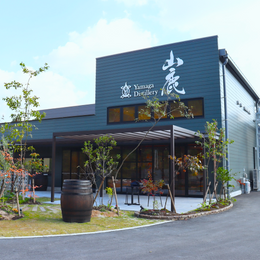Alice Jun Is Helping A World Outside Korea Unlearn Soju And Relearn Sool: In Brooklyn New York, Hana Makgeolli Is Bringing Korea's Historic Sool Back

Korea's national drink Makgeolli and Soju (which together are collectively known as Sool, which is a broad catch-all term for Korean alcohol, although my typically associated with Makgeolli, Soju and everything in between the making of the two) has seen a global surge in interest the likes it's never experienced before in its 2,000 years of history. And so when Alice Jun, a second-generation Korean American, began making and marketing Makgeolli in Los Angeles, California, US, under the brand name Hana Makgeolli - it most definitely made waves. Somehow it never quite clicked that Makgeolli could be made anywhere in the world, not the least of which the US where a substantial Korean community resides in. They say in business that you have to either be the first or the best - in a rare instance, Hana Makgeolli was both in America. Hana Makgeolli became the poster child for traditional Korean alcohol made in the US, and laid claim to also being the first official US-based Makgeolli maker of the landscape today.
There were a handful of Korean Sool makers who came before, however, they never quite made it to scale and had remained small operations before eventually shuttering for a variety of reasons - undeniably in some part victims of a period before the premiumisation of Korean foods (and more broadly culture), where today Korean cuisine is seen as being deeply cultural, requiring of expertise and attention, with its sophistication now significantly better embraced and widely appreciated. The widespread popularity of Korean drinks has even allowed for Soju to currently hold firmly to its number one position globally in terms of bottles sold!
So where did this all begin? It of course all starts with Hana Makgeolli's founder Alice Jun.
"My dad made his first batch of Makgeolli in the U.S. the year I was born, and he kept doing it every year after that, so it just became part of my life."


Born and raised in California, Alice had grown up with Makgeolli brewing as a household ritual - Alice would wash the rice and help fill them into fermentation vessels, and so when she had left for college, she would turn to Makgeolli-making once again as a source of refuge from her homesickness. Even as she graduated and took on a role in management consulting based in New York, she would continue to keep Makgeolli brewing as an anchor in her life. And yet over time, this side hobby would begin to take on a life of its own amongst her friends who found her Makgeolli's both a surprise and a delight, many of whom had never tasted Sool's before. Up till that point, making Makgeolli came intuitively and with little demands as to measurements or specificity. Yet at one gallon became five, and with the increasing scale at which she was brewing, it was inevitable that batches would not go according to plan - this became the rabbithole through which Alice began to properly analyse her brewing, which eventually led to a more meticulous approach towards her Makgeolli's.
Before long, Alice would call her project Hana Makgeolli (establishing the brand in 2017), "Hana" being her own Korean name, as well as meaning "First" in Korean (하나), and would adopt a logo that conveyed a buxom female figure that is meant to pay homage to the role of women in Makgeolli-making (with many Korean women historically in charge of making Makgeolli at home), as well as being shaped like an Onggi, the traditional earthenware vessel used for fermentation in Korean cuisine, whilst also evoking a sense of warmth and of a nurturing quality. With the help of her now business partner John Limb (who first encountered Alice's Makgeolli's at a dinner party), Alice would take her Makgeolli brewing out of her kitchen and into a larger commercial space where she could perfect her Makgeolli's with more precise temperature controls, and with the excitement and interest it drew from even strangers, Alice knew she had to lean in and would thus quit her job in 2019 and focus entirely on Hana Makgeolli. By 2020, Hana Makgeolli would have its own commercial brewery up in Greenpoint, Brooklyn, New York.

"Starting Hana Makgeolli in 2017, I didn’t know what to name it. I thought that it should be a Korean name because we are making traditional alcohols, but then, every Korean name I could come up with felt weird coming out of my mouth. I can speak some Korean, but it’s not my language. But then, to do it entirely in English felt inauthentic too. So I just chose my name! It was the easiest thing!" says Alice Jun.
Along the way, Alice would of course begin to delve deeper into learning and understanding more about her own culture through the lens of Sool, which in turn allowed her to isolate the critical aspects of Sool-making that Hana Makgeolli holds to be core pillars of its brewing and brand. This is particularly crucial considering that Sool is an incredibly wide ranging term that holds little rigidity when it comes to definitions and requirements, and yet somehow is immediately clear to anyone when it does or doesn't evoke a sense of Korean authenticity and quality to it. To identify and even attempt to capture that Korean sensibility about it, we first have to understand what Sool is and its historical context.

The first documented making of alcohol in Korea dates back to some 2,000 years prior (although it is widely believed that alcohol was made in Korea even before the record!), where it held important social and religious functions, often being served to notable members of family, society or as offerings to the gods. As such, much attention was always paid to the quality of these drinks, which extended beyond the fact that precious grains which could otherwise be eaten had to be set aside to produce these beverages. Given the scarcity of grains and also the important characters to whom these drinks were served to, Sool-making would improve throughout Korea's history, even leading to regional styles being developed, with even particular styles favoured during the reigns of various dynasties. This persisted as a staple of Korean households, where traditionally women were in charge of making the Sool, as it was considered part of housekeeping activities - although today, pretty much everyone makes it.
Sool-making in particular flourished during the abundant Joseon Dynasty (14th-19th Century, lasting 505 years and ending in 1897), which is also the era in which most period K-dramas are set in. Unfortunately during the Japanese occupation of Korea from 1910 to 1945, much of the expertise and development around Sool-making would dwindle when grains became rationed and thus homebrewing became banned, with only taxed industrial brewing permitted. The decades that followed remained incredibly difficult, with famine and war persisting in clamping down on Sool-brewing, leaving even only large scale industrial brewers in Korea the ability to brew with less prized agricultural produce such as tapioca and sweet potato. It wasn't until the late 1990's that the ban on rice-based alcohol brewing was lifted, which allowed the return of a form of Sool that stood closer to its historical likeness. As Korea began to prosper once again, and Korean pop culture (termed Hallyu) had started to spread internationally, large scale commercial alcohol makers in Korea found massive success with cheap industrially produced alcohols and a variety of flavoured Soju's and Makgeolli's. This eventually settled into a dominant oligopoly largely contested between two major companies that together hold 80% of the market share for all Soju and Makgeolli's.

Nuruk is core to Hana Makgeolli, where the New York brewery imports the fermentation starter from the last of one of only two traditional nuruk makers in Korea.
Diving deeper into what exactly Sool is, it's worth noting that "Sool" itself simply means "alcohol" in Korean, and this largely comes as a result of how the two most popular Korean alcohols, Makgeolli and Soju, are made. In it's most classic form, grain - with rice being the gold standard - is first steamed (after washing, soaking and draining for hygiene purposes of course) and cooled, where it's then mixed in with water and a fermentation starter called nuruk which comes in the form of a dried cereal cake, which allows fermentation to start to occur (additional yeast is optional but not necessary).
This nuruk is thus a key differentiator of Korean Sool's as compared to rice alcohol made anywhere else - the nuruk being a polyculture of fermented grains such as rice, wheat or barley that already contains various cultures of wild fungi, yeast and bacteria that thus induces an almost wild fermentation in the Sool, allowing for the starch in the rice to saccharify into fermentable sugars that are turned into alcohol (rice alone does not contain enough sugars that can be directly fermented). Unlike Japanese Sakes which also makes use of rice (which is polished to remove the bran or husk of the rice grain, unlike with Sool where the rice is largely unpolished to keep that bran) and a starter called koji - koji being a fermentation starter that performs the same role as nuruk, yet differs by being a monoculture of only one strain of bacteria called aspergillus oryzae and thus produces a more singular and well-defined fermentation and resulting flavour - Sool undergoes parallel saccharification and fermentation from the moment the nuruk is added, whereas Sakes still require the addition of yeast after the koji is added, where fermentation then kicks off. A quick and dirty way of thinking about this is that nuruk is an all-in-one starter which produces more spontaneous and unpredictable flavours!

Two sides of the same fermentation!
Once fermentation is complete and allowed to settle, what will be left is a sedimentation of lees (from the rice and nuruk) and a yellow tinged layer of clear liquid above. When separated, it is this base layer of sedimentation that is called Makgeolli (or Takju), whilst the layer of clear liquid above is known as Yakju (or Cheongju) - when distilled, it is the Yakju that becomes what is thus famously known as Soju! Yet, the reality is that this is but the most basic procedure for making Korean alcohol, and is termed one-step fermentation (or Danyangju), where in practice, Sool-makers are able to turn this basic recipe into a more complex one that can in fact become a two-, three-, four-, five- or even six step fermentation process where after one fermentation is complete, a subsequent fermentation is made to take place, thus creating something even more sophisticated.

Historically a basket was placed in the onggi which allowed for the clear Yakju to be seamlessly separated from the sedimentation of the Takju.
What's even more fascinating is that historically it was the clear Yakju that was given to the higher status nobleman, whilst the Takju (or Makgeolli) was largely reserved for labourers, and was thus nicknamed the farmer's drink, with the word "Makgeolli" itself translating as "roughly filtered", describing the sediments it contained! And thus when understood as various alcohols stemming from in fact a single process, we can now grasp the all encompassing nature of Sool.
"How often does it happen that a product is truly so novel? And how often does it happen where within grape wine there’s this huge natural wine movement? In the same context and in the same markets, sake is also starting to mature and people are really starting to understand that there’s an industry. And then on top of that, craft beer, when it comes from an IPAs and sour perspective, is plateauing, and then it's moving into saisons and lambics.How often does that all happen right at the same time? All of those things were happening all at once and makgeolli is dead straight in the center from a chemistry perspective, from a fermentation perspective, and a flavor perspective."

The rising culinary pursuit of quality Korean cuisine necessitated a rise in the quality of Korean liquors as an accompaniment.
Korean chefs making top level Korean cuisine needing high quality Sool that they could pair with, whilst K-pop and K-drama's were becoming incredibly popular with even non-Korean speaking fans, Alice knew she had a golden opportunity where for once all these trends were converging. And so going back to Hana Makgeolli, what was underrated yet pivotal - arguably what allowed for the sustained success of Hana Makgeolli - was Alice's formative work in defining what the brand stood for. With the broadness of producing Sool, it's all too easy to be lost in terms of the multitudes of possibilities, which in turn dilutes brand equity and therefore distracts and disallows fans from adhering to the brand for lack of distinctiveness or recognisability. By setting down core pillars that revolved around artisanally creating authentic Korean-inspired drinks, paying homage to and preserving the history of Sool, whilst also remaining experimental and creative, Hana Makgeolli has become the face of artisanal Sool globally. Their range of Sools allow fans to delve into the classic styles (the Yakju and Takju), whilst also leaving room for going in-depth into more historical styles (like the botanical Hwaju that makes use of Korean ingredients like Omija berries and Chrysanthemum flowers), and also keeping headroom for experimental Sools (such as those made from alternative grains like brown or black rice) - all made with organic ingredients, fuelled by traditional Korea-sourced nuruk, and also crafted completely natural with no additives or sugar. Never has another brewery or brand better told the story of Korean Sool - where most breweries would simply flavour their Makgeolli's or Soju's, or simply term their drink a generic Soju, Hana Makgeolli has a stable of dedicated expressions that unpacks it all and takes fans on a journey through the Sool category, history and process. Instead of the typically sweet and flavoured contemporary Makgeolli's and Soju's that are widely and cheaply available, Hana Makgeolli's presents a more authentic and original interpretation that hits closer to what Sool really is.

Rather than simply relegating Makgeolli (and Soju) to simply being a canvas for various artificial and confectionary flavours, Hana Makgeolli has sought to deepen the understanding and appreciation for the range of Korean Sool's that exist.
"I do think that the contemporary styles of Makgeolli and Soju that exist in majority volume in the market today are a little bit misleading. Yes, there is a time and place and more pockets that are able to afford and access Makgeolli that is made from tapioca starches, potato starches, and refined enzymes and yeasts, and sweetened with aspartame. Because they have this pleasant, sweet, and sodapop-y taste, and it’s only 6% ABV, and with Soju too. It’s very, very affordable, 15% to 25% ethanol petroleum, but it’s still food grade, right?
And that’s what Hana Makgeolli is about: trying to carve out that space, trying to convince people that actually, you can like the sweet and sodapop-y stuff, there’s nothing wrong with that, but these traditional flavors are also relevant to our palates. And by ignoring this tradition, you are wasting thousands of years, many, many generations of effort, in trying to preserve this methodology and to pass on these flavors. You know, there’s more and more of us that are starting to brew Makgeolli outside of Korea too, that feel that there is no room in the Korean market of Sool for what the original product of Sool was."

At Hana Makgeolli (which Alice admits should really today be more of Hana Sool), it all starts with a blend of whole grain and coarsely grounded organic medium-grain white rice sourced from a single farm in Sacramento Valley, California, where the brewery has only ever worked with the one family behind Polit Farms. It then uses nuruk (specifically made of wheat and barley that's innoculated predominantly with rhizopus and wickerhamomyces, along with various lactobacillus) that is specially imported from South Korea - in particular from Songhakgokja (located in the Jeolla-do Province of southwestern Korea), which is just one of the only two remaining independent commercial nuruk producers, both in a bid to support traditional nuruk makers who carry on hundreds of years of tradition and expertise (where many other nuruk makers have died out), as well as New York being an urban environment and therefore not possessing of the right ambient yeast to produce quality nuruk - which is first soaked in filtered New York tapwater (that's specifically left untreated and not mineralised, but is removed of chlorine) and then filtered to produce a nuruk "tea" that is then slowly mixed in with the rice in steel tanks - this is done over the course of a week and a half.
"Our brewing philosophy steers away from the methods used by imported conventional makgeollis and instead puts quality and authenticity at the forefront. We do not sweeten, dilute, or add stabilizers or flavorings of any kind and all processes are designed to mimic the handmade methods used by the best Korean brewers."

Once the nuruk culture is deemed to be in a good state and fermentation begins, the mash is then allowed to ferment for 30-70 days (staggering compared to the more standard practice of 7-14 days). It's worth pointing out that no additional yeast is pitched to the mash, and thus the three ingredients alone (rice, nuruk and water) are allowed to ferment to full dryness or near dryness depending on the type of Sool created. The potential alcoholic proof, depth, complexity and residual sugars achieved in successive stages is built upon this initial primary one-step fermentation which sets the basis for the various types of Sool's to be made. Most of Hana Makgeolli's Sool's range between a three-stage fermentation to a five-stage fermentation so as to develop more complexity of depth and flavours, whilst the occasional six-step fermentation is also created from time to time. Once completed, the brewery typically aims to minimise intervention and if clarification is needed, it has to be done naturally and without fining agents, with sulphates and stabilisers (including sorbates) also eschewed. Even in the case of the hwaju which sees the use of a botanical infusion for co-fermentation, it is the natural ingredient itself that is used, and not an extract. In total, most of Hana Makgeolli's expressions take up till a week-and-a-half to three weeks just to be ready for fermentation, with then fermentation taking anywhere between four to eight weeks to be completed. In a bid to make sure that its brews are packing full flavour, Hana Makgeolli's expressions typically land at a higher alcoholic proof of between 10%-16% ABV. Whilst so much of the brewery's work is incredibly artisanal, when asked what is the one defining aspect of Hana Makgeolli's brews, Alice is nevertheless quick to emphasise the use of nuruk which sets them apart (where many commercial Korean alcohol makers typically rely on industrial yeast that optimises for efficiency and predictability).
"For us the way we define it is nuruk, first and foremost. Without nuruk, as I was mentioning before, the sool that we know wouldn’t exist, even the conventional stuff. It’s really important to us to try to show people the power of nuruk, the beauty of nuruk. The versatility of it. And from a commercial perspective, it’s important to try to make a point that it’s sufficient, that you don’t need all these other things." says Alice.

Hana Makgeolli's Greenpoint, New York brewery has become a mecca for Korean cuisine.
When Alice had first established Hana Makgeolli, it was the first and only of its kind (where previous Sool-making operations had by then ceased) - today, some 8 years later, there are at least 7 others in the US. Yet, Hana Makgeolli has hardly stood still. Expanding upon its Greenpoint, New York brewery, Alice and John have made it a mecca for learning and experiencing first hand Korean cultural cuisine, with both the brewing facilities visible to visitors, as well as a revolving line-up of visiting chefs and restaurants running Korean-inspired pop-ups pairing food with Hana Makgeolli's Sool, keeping the brewery's kitchen well utilised. Examples include clams steamed with butter, Sool and red curry paste, as well as sausages made of Makgeolli lees served with pickled chillies and ground pork. At any one time, the brewery produces up to 1,000 litres of Sool, making use of some 800 pounds of organic rice, all of which is open to visitors to experience. Visitors are also able to go on brewery tours, enjoy tasting flights of the various Sool expressions, attend Makgeolli making classes, and purchase the Sool's of course - special limited brews are set aside for members of the Hana Sool Club.

Chrysanthemum co-fermented with rice for Hana Makgeolli's Hwaju.
Whilst keeping the entire Sool operation churning, Alice has also continued to press on with innovation and creativity by regularly releasing new creations. Hana Makgeolli might just be the first to officially and regularly produce Hwaju ("Hwa" meaning "flower" and more broadly "botanical", with "Ju" taken to mean "alcohol"), which was conceived with the hope of casting a spotlight on traditional Korean botanicals. The core range includes a Hwaju, the Hwaju 12, that is co-fermented with actual chrysanthemum and hydrangea, creating floral flavours in the Makgeolli. Other regular botanical Makgeolli's includes the Omija Makgeolli that is made with the popular Korean Omija berry that is often told by Korean parents to their children as a natural supplement for youthful skin. Alternative grains beyond the organic medium-grain white rice, such as brown and black rice, also go into the Hyunmi Takju and Forbidden Takju. The brewing team continues to experiment with everything from Schisandra berries to elderflower, and mugwort - yet unfortunately remain constrained to having to use FDA certified ingredients, a list that remains limited due to the lack of coverage over ingredients that are not native to the US. More recently, the brewery also produced its first ever Soju spirit - the flagship Takju 16 was allowed to ferment for an additional 72 days, after which it was distilled in a copper still (at Matchbook Distilling Co.), which resulted in a Soju that came in at roaring 60% ABV, where conventional industrially produced Soju's typically tap out at 15-25% ABV. Some of these distilled Soju's have since been aged in barrels. Along the way, collaborations were of course to be expected and have taken on imaginative forms, with the likes of a Makgeolli fermented with peppers and plums that was created for KJUN chef Jae Jung.

“Makgeolli is an alternative to craft beer, natural wine, and sake. And really it’s at the intersection of those three categories.”
Yet perhaps most exciting of all is the recent creation of the brewery's first canned Makgeolli - named MAQ 8 Silkysonic, the small fire engine red can is given a cute marshmallow-meets-whipped cream looking mascot that is designed to convey a sense of being chock full of energy and rearing to go. Contained inside is a single serve of gluten free Makgeolli at 8% ABV, deliberately carbonated and allowed to ferment for shorter so as to preserve some natural residual sugar, giving it a delicately sweeter, more creamy and richer flavour with a light effervescence.
Yet with a whole world of Sool left to unearth - from the medicinal Yakyong Yakju to the compound Honseongju, and even the mixed liquor that is Honyangju, as well as just the sheer number of botanicals and multi-stage fermentation cycles to toy with - it's clear that Hana Makgeolli has only just begun revealing the tip of the iceberg.

@CharsiuCharlie






